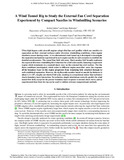JavaScript is disabled for your browser. Some features of this site may not work without it.
| dc.contributor.author | Sabnis, Kshitij | |
| dc.contributor.author | Babinsky, Holger | |
| dc.contributor.author | Boscagli, Luca | |
| dc.contributor.author | Swarthout, Avery | |
| dc.contributor.author | Tejero, Fernando | |
| dc.contributor.author | MacManus, David | |
| dc.contributor.author | Sheaf, Christopher T. | |
| dc.date.accessioned | 2023-03-05T13:25:15Z | |
| dc.date.available | 2023-03-05T13:25:15Z | |
| dc.date.issued | 2023-01-19 | |
| dc.identifier.citation | Sabnis K, Babinsky H, Boscagli L, et al., (2023) A wind tunnel rig to study the external fan cowl separation experienced by compact nacelles in windmilling scenarios. In: AIAA SciTech Forum 2023, 23-27 January 2023, National Harbor, Maryland, USA | en_UK |
| dc.identifier.uri | https://doi.org/10.2514/6.2023-1942 | |
| dc.identifier.uri | https://dspace.lib.cranfield.ac.uk/handle/1826/19260 | |
| dc.description.abstract | Ultra high-bypass ratio aircraft engines adopt slim fan cowl profiles which are sensitive to separation on their external surfaces under diversion windmilling conditions, when engine shutdown occurs during cruise. A two-dimensional wind tunnel rig is developed to investigate the separation mechanisms experienced by aero-engine nacelles in such scenarios to establish the detailed aerodynamics. The tunnel flow field with entry Mach number 0.65 broadly replicates the expected diversion windmilling flow behaviour for a full-scale nacelle, featuring a supersonic region which terminates in a normal shock wave on the external fan cowl surface. For the three conditions investigated, which relate to different engine mass-flow rates, the response of the boundary layer in this region progresses from remaining fully attached through to well-established separation. However, the rig Reynolds number based on nacelle lip thickness is about 1.2 million, roughly one-third of full scale, resulting in a transitional rather than turbulent shock-boundary-layer interaction. Nevertheless, simple simulations correctly predict the wind tunnel flow field, except for the precise boundary-layer response to normal shock waves, and so experimental data from the rig can be used to validate relevant computational methods. | en_UK |
| dc.description.sponsorship | European Union funding: 101007598 | en_UK |
| dc.language.iso | en | en_UK |
| dc.publisher | AIAA | en_UK |
| dc.rights | Attribution-NonCommercial 4.0 International | * |
| dc.rights.uri | http://creativecommons.org/licenses/by-nc/4.0/ | * |
| dc.title | A wind tunnel rig to study the external fan cowl separation experienced by compact nacelles in windmilling scenarios | en_UK |
| dc.type | Conference paper | en_UK |
| dc.identifier.eisbn | 978-1-62410-699-6 |
Files in this item
The following license files are associated with this item:
This item appears in the following Collection(s)
-
Staff publications (SATM) [4365]

